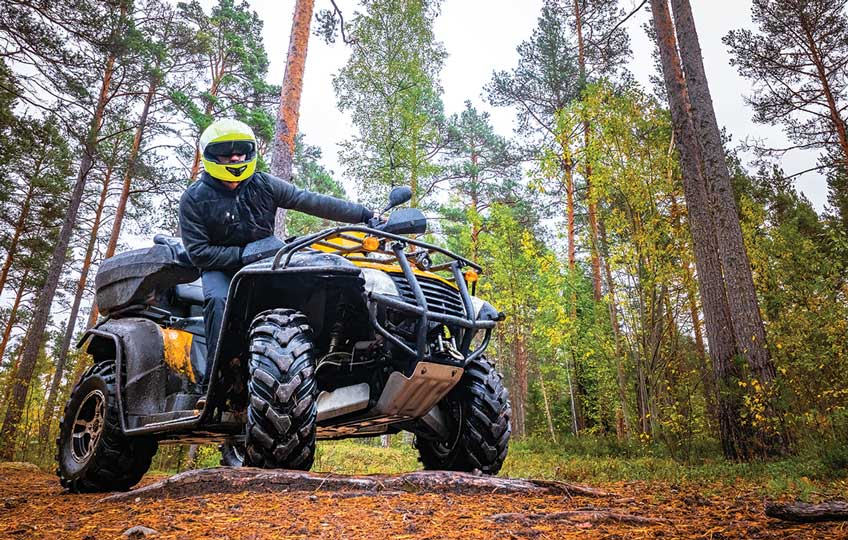ATVs: Not the Same as “Seen on TV”
By MS. PAULA COLLINS, STAFF WRITER
All-terrain vehicles (ATVs) are a popular source of summer entertainment. Whether you like mountains, prairies, dunes, or beaches, you can take an ATV there. If you do not own an ATV, they are often available for rent at venues that offer off-road riding opportunities. What better way to soak up the sun and fresh air with family or friends than on an ATV?
ATVs are appealing because they appear safe and easy to operate. These vehicles come in a variety of styles and sizes, ranging from youth-sized ATVs that have small engines to match their small sizes and weights, to large ATVs with up to 1,000-cubic centimeter (cc) engines that can accelerate to more than 75 miles per hour (mph). It is important to select an ATV that fits the rider’s size and skill level.
Riders should be familiar with their ATV’s throttle, brakes, and steering features before hitting the trail. Often ATVs can be operated with the handlebars and shifter alone, making it possible for even a child to operate a larger, more powerful vehicle. Ensure children do not have access while unsupervised by always removing the key when you are not riding. Typically, ATVs are intended for one rider, even though the seat will often accommodate two. If your ATV is rated for two riders, it will be indicated somewhere on the vehicle.
Remember to do the following when getting ready to ride:
- Learn about the area in which you will be riding.
- Stay off of paved roads.
- Inform others of your planned location and carry a cell phone, water, and snacks.
- Avoid any substance that could cloud your judgment.
- Start out slow and observe the lay of the land for any obstacles.
- Proper attire is essential for a safe, comfortable trail-riding experience.
- Wear a U.S. Department of Transportation-approved helmet, goggles, gloves, long sleeves and pants, and boots to protect you from brush, rocks, and abrasions.
- Never wear shorts or flip-flops.
You may have watched events at which the riders achieve high speeds and jump from fantastic ramps with their ATVs. It looks so exciting, and it might make you want to experience the thrill of being airborne on your ATV. It is important to remember that they are professionals who wear body armor and train daily for competitions on well-maintained tracks.
Your safety as a recreational rider depends on having a healthy respect for the environment in which you will be riding, as well as the power of your ATV. A leading cause of accidents is driving over unfamiliar terrain. Dry grass can cover a multitude of hazards, such as washes and ravines, rocks, stumps, and even deer antlers. Hitting any of these objects can cause the top-heavy ATV to tip sideways or flip end over end, causing the operator to be thrown from the vehicle and possibly crushed by it. Great care should also be taken when approaching the top of a hill because you do not know what is waiting on the other side. It could be a boulder or another rider. Inexperienced riders may miscalculate the handling aspects of an ATV, especially at high rates of speed, and be unable to react effectively to avoid an accident.
According to the U.S. Consumer Product Safety Commission (https://www.cpsc.gov/Safety-Education/Safety-Education-Centers/ATV-Safety-Information-Center), 96 percent of injuries and over 30 percent of deaths from off-highway vehicle crashes (of which ATVs are a subset) are specifically attributed to ATVs. Each year there are an average of 100,000 emergency room visits, with 43 percent belonging to the 16-to-24 and 25-to-34 age cohorts combined. An average of 700 fatalities occur, with approximately 300 being children under the age of 16. Injuries to the head and neck and injuries to the arm each accounted for 30 percent of injuries sustained. Torso and leg injuries accounted for 20 percent each. Most ATV accidents occur because of the following:
- Inexperience
- Unfamiliar surroundings
- Dangerous stunts
- Extra passengers
- Alcohol or drugs
While the dangers of riding ATVs are real, they are also preventable. If you follow good safety protocols, these powerful vehicles are well within your ability as a rider to control. Learn how to have fun and be safe at the same time. More detailed safety information is available at https://atvsafety.org/free-booklets/.
| ATV Size | Engine Size (cc) | Maximum Speed* (mph) | Weight** (lbs.) | Driver Age |
| Small | 50 | 17 | 200 | 6+ |
| Small | 70 | 10 | 245 | 6+ |
| Small | 90 | 32 | 265 | 10-12 |
| Mid-Size | 200 | 38 | 420 | 14+ |
| Mid-Size | 250 | 60 | 430 | 14-16 |
| Mid-Size | 270 | 40 | 450 | 14-16 |
| Mid-Size | 300 | 40 | 540 | 16+ |
| Mid-Size | 400 | 67 | 600 | 16+ |
| Mid-Size | 450 | 73 | 650 | 16+ |
| Large | 500 | 63 | 700 | 16+/adult |
| Large | 650 | 73 | 750 | 16+/adult |
| Large | 700 | 71 | 750 | 16+/adult |
| Large | 800-850 | 75 | 800 | 16+/adult |
| Large | 1,000 | 81 | 860 | 16+/adult |
**Average weights: models intended for mud or hunting may be equipped with larger tires, heavy duty shocks, and winches, all contributing to a heavier ATV.
Source: https://wildatv.com

